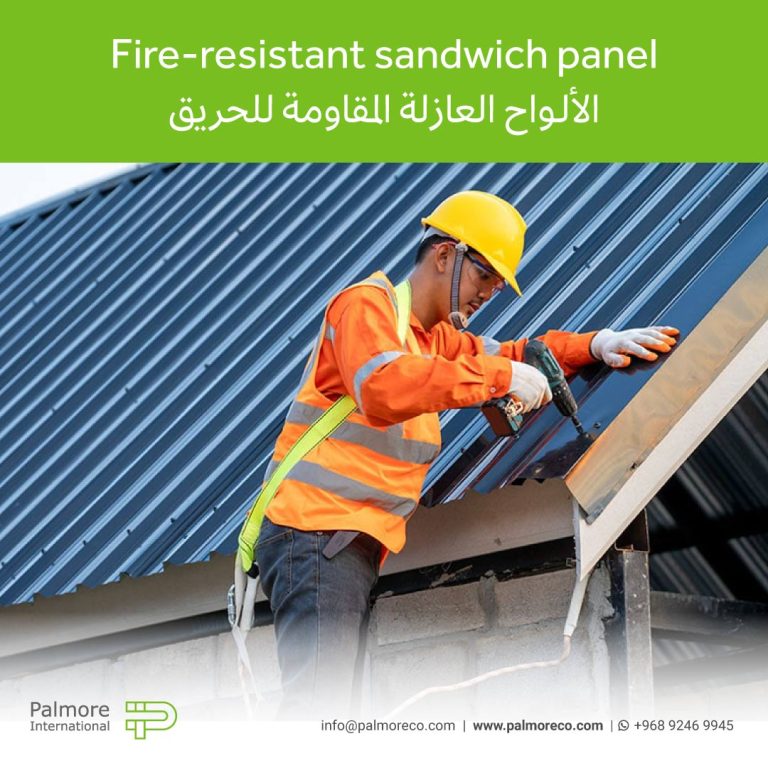
What is the fire resistance of the sandwich panel?
Fire-resistant sandwich panels are a good alternative to traditional materials, such as brick and cement. This type of panel has many applications. Fire-resistant sandwich panels or Refractory type is one of the types of panels that is not flammable if there is no direct flame. These panels are resistant to direct heat and in this type of panel, they extinguish themselves after the fire subsides. This feature is due to the type of construction and materials used in it. In the following, we will fully explain it to you.
Introducing Fire-resistant sandwich panel
The use of such panels in furnaces is specified. This type of panel, which is produced with rock wool insulation, has a high resistance to direct heat and is resistant and will not melt during a fire and does not increase the risk of flames. In addition to being heat resistant, it is highly regarded for its security in the building. That is why it can be used in many parts. Because it is a very safe and cost-effective option due to its high safety and security.
Features of Fire-resistant sandwich panels
This is a fire panel.
It does not release any toxic substances during a fire.
The fire is extinguished after it subsides.
This panel has a high thermal performance that saves.
Compared to other sandwich panels, it is healthier and has Arad fiber.
Has FM fireproof standards.
Resistant to chemicals and acids.
Sandwich panels can be assembled and disassembled.
Features of Fire-resistant sandwich panel
Uses of fireproof sandwich panels:
Workshop offices and clinics
Commercial office buildings
Covering sheds and warehouses
Schools Pools and hotels
Sports complexes
Temporary accommodation camps and caravans
Relief units
Technical specifications of Fire-resistant sandwich panels
Polyurethane insulation that is used in sandwiches such as ceiling and wall is fireproof and their thickness (15-12-12-10-8-6-5-4) and is made according to the length and color desired by the customer. The sheets in the refractory panel are made of allozinc, galvanized and parasitol. The toxin released when burning from the isotonic foam is very low. For this reason, this panel can be used in many cases.
Fireproof sandwich panel insulation
This insulation is made of rock wool fibers. This insulation consists of basalt volcanic rock. Basalt is composed of volcanic igneous rocks. These materials, along with the middle insulation of the panel, prevent the panel from catching fire and spreading fire. This has increased the safety of this product and has become one of the safest products in the construction of structures.
The panel type is used in different parts. Today, safety is one of the most important factors in the construction of various structures. For this reason, the use of this type of panel is very practical and engineers and experts use it.
Types of ceiling sandwich panels
Ceiling sandwich panel:
Types of fireproof sandwich panels
Roof sandwich panels are produced in the form of two sides of sheet, one sheet of foil, one sheet of nylon and one sheet of paper. Sheets of this type of panels can be produced in the form of sinusoidal (shutter), chandelier, trapezoidal design and pottery design. These panels are used as roofing for industrial buildings, transport containers, warehouses and silos.
The advantages of roof insulation panels are heat, cold, low price, low weight, easy installation and resistance to wind, earthquake and chemicals. Ceiling panels are one of the best prefabricated buildings that, in addition to high safety, also have a beautiful appearance and good design.
Wall sandwich panel:
Variety of products in Fire-resistant sandwich panels
Wall sandwich panel is a ready-made building material that consists of two layers of sheets between which is foam and is used for facades and walls. The sheets of this wall panel are galvanized, allozinc and aluminum, which have anti-corrosion properties, high resistance and low price. This type of panel is used for interior walls with a thickness of 4 to 6 cm.
The advantages of this type of panel include: heat and cold insulation, wind and earthquake resistance, recyclability, easy transportation, easy installation and hygiene. It is also used in the construction of various sheds and factories. Because it is resistant to natural factors and other events and also maintains the structure of the structure. To minimize damage to everything inside.
This sandwich panel consists of 3 layers:
Cover on the panel
The middle core of the panel
Cover the back of the panel
How to resist fire
In fireproof sandwich panels, a stable protective layer is formed during a fire. In the core of the half-burned layer, with the expansion of the surfaces, empty spaces are filled and as a result there will be no cavities. At 1000 ° C, 70% of the panel remained unchanged and 30% of it without flame spread and fire spread between the cores. And other panel surfaces are half-burned. In a panel at temperatures above 300 ° C, a protective semi-burnt layer is formed. Panels away from the source of the fire have not undergone any changes.
The importance of using Fire-resistant sandwich panels
As mentioned, the sandwich panel has several features. One of the most important of them is its insulation, which greatly increases the safety of the building. Today, this type of structure is used in most constructions or sheds. In many cases, especially in factories, fires are a factor that destroys all capital and production. In these few years
Many people faced many problems because of this. But using a fireproof panel will solve this problem forever.
Price of Fire-resistant sandwich panels
Because of the thickness, the materials used in the sandwich panel, including sheet metal and foam insulation, all affect the price of the panel. Therefore, if you want to get more information about the price, you can contact us through the numbers placed in the site and receive the necessary information from our experienced and skilled experts.

